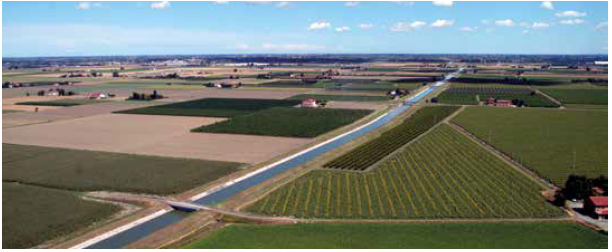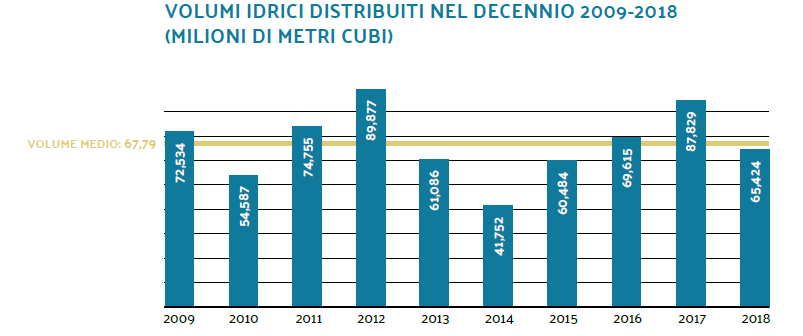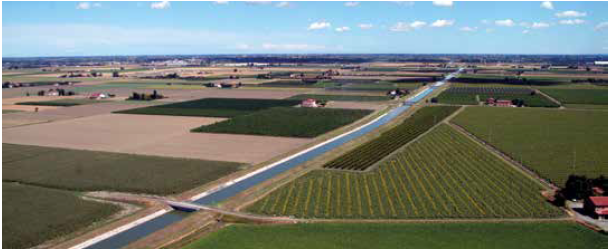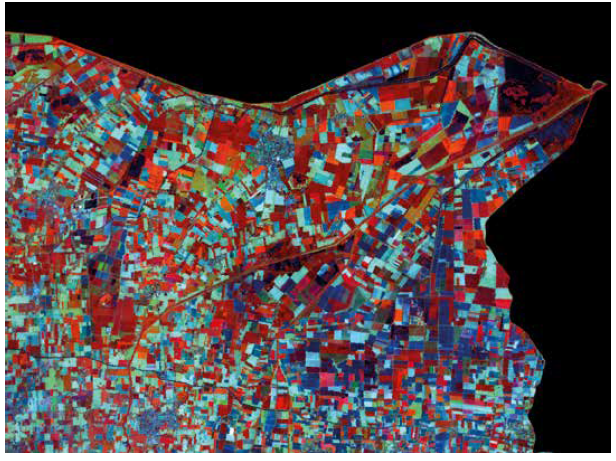Optimisation of agricultural water consumption and distribution in the Reno river basin, Emilia Romagna, Northern Italy

Geographic context and climate challenges
The Reno river basin is mainly located in the Italian region of Emilia Romagna and is part of the hydrographic Po river basin district , managed by the Po River Basin Management Authority, according to the implementation of the Water Framework Directive (2000/60/CE). It has a total surface of about 5,000 km² and includes the territory of important metropolitan cities such as Bologna. During the past 10 centuries, the river underwent extensive channel re-arrangements, channelization, construction of levees, spillways and dams. Before the 12th century, the Reno had no outlet to the sea and poured its waters into a large marshland south of Ferrara. Then, the Reno was channelized and forced to join an old Po channel (Po di Primaro), getting a new downstream (Preciso et al., 2011). After its initial part with a torrential character in the mountainous stretch, the river is designed as “heavily modified” according to the Water Framework Directive (2000/60/CE) as a result of physical alterations by human activity. The final Reno river outlet is in the Adriatic Sea, south of the Po delta and the Comacchio lagoon.
In the area of the Reno river basin, meteoric and surface waters flow through natural courses (rivers and torrents) and artificial drainage canals. The artificial network of canals is managed by different local public authorities for hydraulic works (Consorzi di Bonifica), while natural water courses are managed by the Emilia Romagna Region.
A large part of the territory of the Reno river basin (about 3,419 km²) is managed by the local public authority of Consorzio di Bonifica Renana. The flat area of this territory (case study area) allows for an extensive development of agriculture. The main crop is maize (about 29% of irrigated culture), far larger than other cultures such as beets and potatoes.
On average, the Consortium distributes 68 million m3 per year of water (considering the period 2008-2018) for irrigation and production purposes, allowing irrigation for about 17,000 ha of agricultural land. During 2018 about 65 million m3 of water were used to irrigate about 14,800 ha of the Reno river basin. Irrigation only uses surface water, and the main source for irrigation is provided by the “Canale Emiliano Romagnolo” that crosses the Reno Basin and drains water from the Po river with a total length of 148 km.
Important signals of climate variability have been observed in the territory of Emilia Romagna, as reported in the local Adaptation Plan of Bologna City (developed within the Life Project Blue Ap) and in the Regional Strategy of Adaptation and Mitigation of Climate Change. There is a significant trend in temperature increase, especially in summer (0.6°C per decade in the period 1961-2016 for maximum temperature), while precipitation is slightly decreasing considering the average annual values, with seasonal variations. Moreover, the number of consecutive dry days is increasing, especially in summer, while an increasing frequency of intense precipitation events has been locally observed. Future projections generally confirm the past trends, with values and significance that depend on different assumed scenarios. For the period 2071-2100, considering the A1B IPCC SRES and RCP4.5 scenarios, the projections suggest an average regional increase of temperature between 3°C and 4.5°C.
Drought and water scarcity, heat waves in urban areas and extreme events, and hydro-geological risk have been identified as the main elements of vulnerability for the Bologna city, which is part of the territory of the Reno basin, in its adaptation plan.
Water saving in the context of present and future climate variability, with possible increasing water scarcity phenomena, is a clear challenging objective for the Consorzio di Bonifica Renana, due to its responsibility for water distribution to agricultural areas for irrigation purposes. Indeed, water saving in agriculture is a common challenge for the entire Po River Basin District, considering that 80% of water resources of this basin are used for irrigation. Accordingly, the Po River Basin Management Plan, first drafted in 2010 and then updated in 2016, as well as the Water Balance Plan for the Po River (2016) recognize the central role of those measures aimed at reducing the water use for irrigation, due to the large volumes taken for this purpose from the Po river basin, especially during the summer season. These plans encourage the objective of improving the irrigation efficiency in order to achieve a reduction of water withdrawal for irrigation of 5% in the whole basin of the Po river. In this planning context, a reduced water withdrawal is specifically pursued to: (i) allow the achievement of the environmental quality objectives of water bodies according to the Water Framework Directive, ensuring their minimum vital flow; and (ii) increase the resilience of water resources to droughts and future water scarcity as foreseen by climate change scenarios.
Objectives
Consorzio di Bonifica Renana launched “Acqua Virtuosa”, a programme of collaboration with farmers to optimise water consumption for irrigation purposes, with the following objectives:
- Save water resources through the optimisation of water used for irrigation, both at the basin level and at the farm level.
- Collect data needed to define specific variable quotas that farmers have to pay for irrigation according to the culture typology, the estimated water volume needed for irrigation and the water distribution mode. As described in the following sections, the approach of variable quotas rewards farmers more successful in saving water resources.
- Initiate a direct communication channel with farmers that use water for irrigation purposes.
Adaptation measures implemented in the case
Improvement of irrigation efficiency
Water saving and recycling
Solutions
To face the climatic variability recently experienced and the climate change projected for the future in Emilia Romagna, and to pursue the water saving objective, in 2016 the Consorzio di Bonifica Renana launched the initiative “Acqua Virtuosa” (Virtuous Water), to optimise the water consumption for irrigation in the Reno river basin. According to this initiative, all farmers that use water for irrigation derived from the Consortium distribution network must communicate data of land surface they intend to use for cultivation and specify the culture types. Data are communicated yearly to the Consortium during the months of January, February and March, i.e. before the beginning of the irrigation period. The surface and culture data are stored in a web GIS platform (Tolomeo), specifically dedicated to this project and used by the Consortium operators to visualise and manage the spatial data of all agricultural lots in the entire territory of the Consortium competence. These data are used to perform an early annual estimate of the overall water demand for irrigation, and to compare this need to the water resource availability from the artificial network managed by the Consortium. The irrigation demand and water balance can also be assessed at the district level, i.e. considering all agricultural areas that depend on the same irrigation canal.
This system allows the Consortium to early recognize and manage possible critical situations related to water scarcity, which occur especially during summer and consumption peaks. Therefore, possible practices for water saving can be activated. In the case of excess of water, water distribution can be switched off, avoiding to distribute water where and when it is not needed. Thanks to the detailed knowledge of the water balance for each district, in the case of water scarcity specific turning mechanisms for irrigation can be established according to the real needs of each agriculture lot. The computerised system also allows a constant communication with farmers through SMS, keeping them well informed on the opening and closing of the irrigation season, possible water deficit and solutions implemented to address critical situations.
A control of data yearly communicated by farmers is performed through direct field surveys and through the use of satellite imagery techniques (LANDSAT 8 and SENTINEL 2A), that allow to assess soil humidity and hence to identify possible areas irrigated but not declared to the Consortium.
“Acqua virtuosa” also envisages that all farmers participate in the project IRRINET (Irrigation Advisory Services for Farm Water Management; see also the related Climate-ADAPT case study) of the Emilia Romagna Region that allows farmers to properly plan their irrigation needs, reducing water consumption. The IRRINET irrigation service is a free service that delivers suggestions to the Emilia Romagna farmers on irrigation (when to irrigate and the water quantity to be used) to obtain good quality products while saving water resources.
At the same time, a new regulation (“Piano di Classifica”) entered into force in 2016, establishing a new system to define the economic contribution (quotas) that farmers usually pay to the Consortium for water consumption. Also taking into account the climate changes that occurred over the past 20 years, quotas are now established not only on the basis of the owned agricultural surface (fixed quota) but also on the crop types (favouring agriculture types with lower water needs), the water volume estimated for the irrigation of each crop type and the water distribution mode; these three latter elements contribute to determining the variable quota. This system acts as an incentive for the most efficient farms encouraging the reduction of water consumption.
Leader of the initiative and key partners
The leader of the “Acqua Virtuosa” initiative is the local public authority Consorzio di Bonifica Renana that brings together all the land and building owners located within its district which is part of the Reno river basin. According to national and sub-national regulations, this authority carries out essential functions both in the flat part (hydraulic works and water distribution), and in the hilly and mountainous part (hydro-geological control) of the district. In the flat area it has competence for the hydraulic works, ensuring water distribution for different purposes, especially irrigation. Through the artificial hydrographic network of the basin, this authority ensures safe water outflow of meteoric waters from agricultural and urban areas.
The institution was founded in 1909, with the main objective of managing the hydraulic restoration of the area, included in a territory that, abandoned after the fall of the Roman Empire, was considered to be a marshy and unhealthy area, exposed to continuous flooding.
The Consorzio di Bonifica Renana, as the other consortia of the region, receives funding from the Emilia Romagna Region, through its Soil and Coast Protection Service, for the construction or renovation of hydraulic works. The regional Soil and Coast Protection Service has a coordination role for the consortia activities, taking care of the general intervention planning, approving projects, and periodically monitoring the state of implementation. The Emilia Romagna Region collaborates closely with the Po River Basin Management Authority preparing periodical updates of the River Basin Management plan and the Water Balance Plan, having a role in defining the water quality objectives and measures, including those related to water saving in the agriculture sector.
Owing to its value for adaptation to climate change, the municipality of Bologna included “Acqua Virtuosa” among the measures of the Adaptation Plan of Bologna City, specifically for the issues of droughts and water scarcity. Long-term key objectives for such issues include the safeguarding of a minimum vital flow of the Reno River with actions aimed at reducing water withdrawals and protecting agriculture-based local communities.
Finally, key partners of “Acqua Virtuosa” are the farmers of the Consortium territory who are directly involved in the initiative, allowing its real implementation and success.
Stakeholder participation
Farmers are clearly the key stakeholders in this initiative, and their active participation determines its success. Moreover, the Consorzio di Bonifica Renana holds regular relations with local authorities, representatives of main business groups, research institutions, cultural and environmental associations of the territory. Dissemination initiatives to the citizens are commonly organised to favour knowledge about the role and the functions of the Consorzio.
In 2016, an extraordinary communication activity was carried out by the Consorzio to present to the public the new “Piano di Classifica”, established by a regional decree, to define new rules for the payment of quotas by all landowners: overall, 26 meetings were organised, 12 of which dedicated to citizens, 10 to farmers and 4 to other economic organisations.
Success and limiting factors
The active collaboration with farmers that have a key role in delivering data, as well as the possibility for farmers to benefit from a more favourable quota in case of cultures with reduced water demand are among the success factors for this initiative. On the contrary, a poor collaboration with farmers, which might imply the provision of inaccurate or unreliable data on crop types and irrigation needs, could limit the efficacy of the system to early manage water stress events.
Cooperation with other initiatives set up at the regional level to favour water saving in Emilia Romagna in the agriculture sector can strengthen the success of Acqua Virtuosa. Besides the aforementioned Piano di Classifica and IRRINET project, other relevant initiatives include the progressive technological innovation in the distribution network of the Consortium, with improvement of gates used to derive water from the main irrigation canal (Canale Emiliano Romagnolo) and the installation of automatic systems of water flow measurement.
In a longer-term perspective, other issues related to the river basin management will also need to be tackled in order to allow gradual re-naturalization of the basin and help mitigate, for instance the lack of sediment flow to the coastal area due to the historical artificialisation of the river. See case study “Bellocchio beach” and “(Ravenna)” for a description of this issue.
Costs and benefits
“Acqua virtuosa” enables reaching an optimised water distribution for the Consorzio di Bonifica Renana, avoiding wasting water and incentivising a more conscientious water consumption by farmers. Farmers that demonstrate efficient use of water can also derive an economic advantage, benefitting from a differentiated system to assign quotas for water consumption.
The system has also offered the possibility of gathering computerised and constantly updated information on land use for agricultural scope in the Reno river basin enabling the Consortium to perform a more efficient management of the territory. A structured communication system with farmers has also been established.
The source of funding is the Consorzio di Bonifica Renana itself, through the economic contribution received from land and building owners for water consumption.
Contacts
Consorzio della Bonifica Renana
Via S. Stefano, 56 – 40125 Bologna, Italy
Davide Rondini
E-mail: d.rondini@bonificarenana.it
Tel.: 051295230.
Source for more detailed information
Consorzio di Bonifica Renana website
Local Adaptation Plan of Bologna City
Report 2019 of Consorzio Bonifica Renana
Map

Pictures

Water volumes distributed in the period 2009-2018 (million cubic meters)
The chart shows the yearly water volumes distributed for irrigation purposes in the territory of Consorzio Bonifica Renana, Emilia Romagna region
Source: Consorzio Bonifica Renana, 2019. Report 2109

Agricultural land and the irrigation canal “Canale Emiliano Romagnolo”
Canale Emiliano Romagnolo is an artificial canal that derives water from the Po river; it is the main source of water distributed in the territory of the Reno river basin for irrigation.
Source: Consorzio Bonifica Renana, 2019. Report 2109

Satellite Images from Landsat 8 and sentinel 2A for the area of the Reno river basin
Satellite imagery allows operators of Consorzio Bonifica Renana to assess soil humidity of land used for agriculture, in order to verify that irrigated areas have been correctly declared by farmers.
Source: Consorzio Bonifica Renana, 2019. Report 2109
